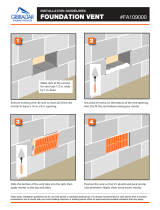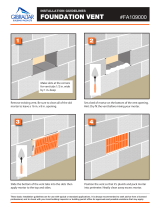
14
• Superior Performance: Featuring high “R”
values, ue surface temperatures are balanced
and react quickly to ring cycles of heating
units. Aiding in optimal heating efciencies.
• Durable & Tested: When properly installed,
TherMix does not leak, separate or deteriorate.
Field tested since 1984.
• Reinforces: Insulates the liner & ue gas
while providing a strong bond for the masonry
chimney.
TherMix lowers temperatures on liners during
over ring or chimney res: Allows heat to
be slowly absorbed into the entire mass of a
chimney, where it is safely dissipated over a
large surface area.
TherMix maintains higher temperatures on lin-
ers when ue gas temperatures are low: Main-
taining ue gas temperatures above dew point,
(~128°F), is essential to avoid condensation.
The insulating mass of TherMix retains the
maximum available heat close to the liner: the
ue stays warm for a longer period of time af-
ter the appliance shuts down. With oil and gas
appliances, keeping the ue warmer between
ring cycles greatly reduces the possibility of
momentary ue gas spillage which occur at
the start of the next cycle. With wood burning
applications, warmer ues help eliminate back
pufng and other draft related problems.
TherMix minimizes uctuations of liner surface
temperatures during heating cycles. This is
critical when draft must be established quickly
each time an appliance res up and when
minimizing condensation within the entire
height of the ue is important.
To comply with the specications of a
UL Listed, zero clearance solid ue installation,
a minimum thickness of 1” of TherMix must be
installed between a listed stainless steel liner
and a 4” thick masonry chimney wall. In veri-
able code-complying, clay-tile-lined chimneys,
no minimum thickness of TherMix is required.
Table 1 shows how TherMix reduces heat
transfer to combustible material surrounding
a masonry chimney. The data is an actual UL
test where chimney ue gasses were main-
tained at 1000°F for an eight-hour period. The
(+) line shows temperatures on a plywood
enclosure located at one-inch from a code ap-
proved, tile-lined chimney. The (n) line shows
temperatures with a Ventinox liner, which is
insulated with TherMix at the same thermo-
couple location. The (*) line shows acceptable
temperature limits specied by the UL stan-
dard, (90°F plus ambient for the rst 4.5 hours
and 117°F plus ambient for the remainder of
the test).
There is no change in consistency of TherMix
over time. Even after exposure to many high
temperature tests at UL, the structural integrity,
chemical composition, and insulating qualities
remained consistent over time, every time.
• TherMix insulated chimneys can be used
right after the installation is complete, as
long as ue gas temperatures do not exceed
1000°F during the rst 48 hours of actual use.
Please note that drying and curing are two
separate processes:
• Curing or hardening of TherMix takes place
over a 28-day period, with 65% to 75% of this
process occurring the rst week.
• Drying time depends on the thickness
TherMix, the permeability of the chimney, and
weather conditions. The drying process is
enhanced and completed over time by using
the heating appliance.























